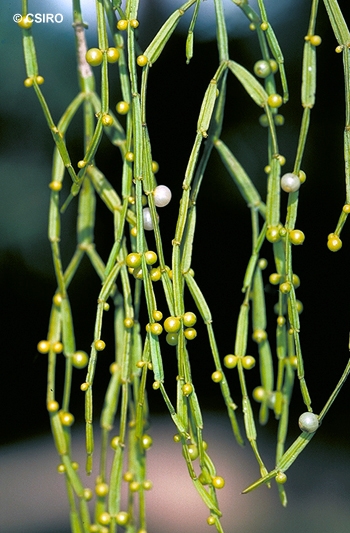Australian Tropical Rainforest Plants - Online edition
Viscum articulatum Burm.f.
Burman, N.L. (1768) Fl. Indica : 211. Type: Java; Holo: ?.
Stem internodes 4-angled or 4-ribbed (at least when young), about 8-37 x 1-4 mm with a distinct 'midrib'. Usually parasitising Loranthaceae, Viscaceae or Santalaceae. Plants pendulous, up to about 1 m long.
Leaves absent or very small. Internodes about 1.5-4 x 0.2-0.3 cm.
Fruits almost translucent, sessile, globular, about 3.5-5 mm diam. Tepals not persistent. Seeds green, flattened about 2.5-4 x 2.5-3 mm. Testa translucent sometimes marked by white lines and sometimes with an attached sticky hair. Endosperm green but paler than the embryo. Embryo green, lateral, about 1.3-2 x 0.4-0.5 mm. Cotyledons about 0.6-0.7 mm long, narrower or much narrower than the radicle.
Features not available.
Occurs in WA, NT, CYP, NEQ, CEQ and southwards as far as southern coastal NSW. Altitudinal range in north Australia from near sea level to 1100 m. Usually parasitic on Loranthaceae or other Santalaceae, in broad range of vegetation communities including open forest, rain forest and vine thickets.
Grows as a parasite on other parasites particularly Loranthaceae, also on Exocarpos.
May have medicinal properties.







